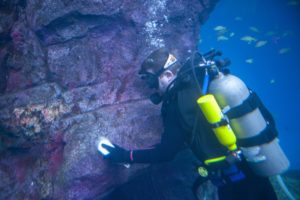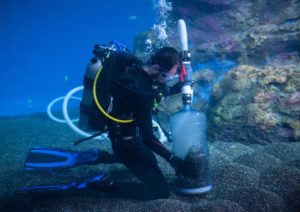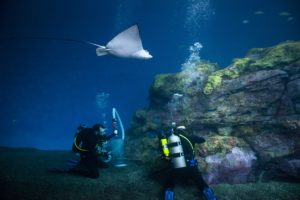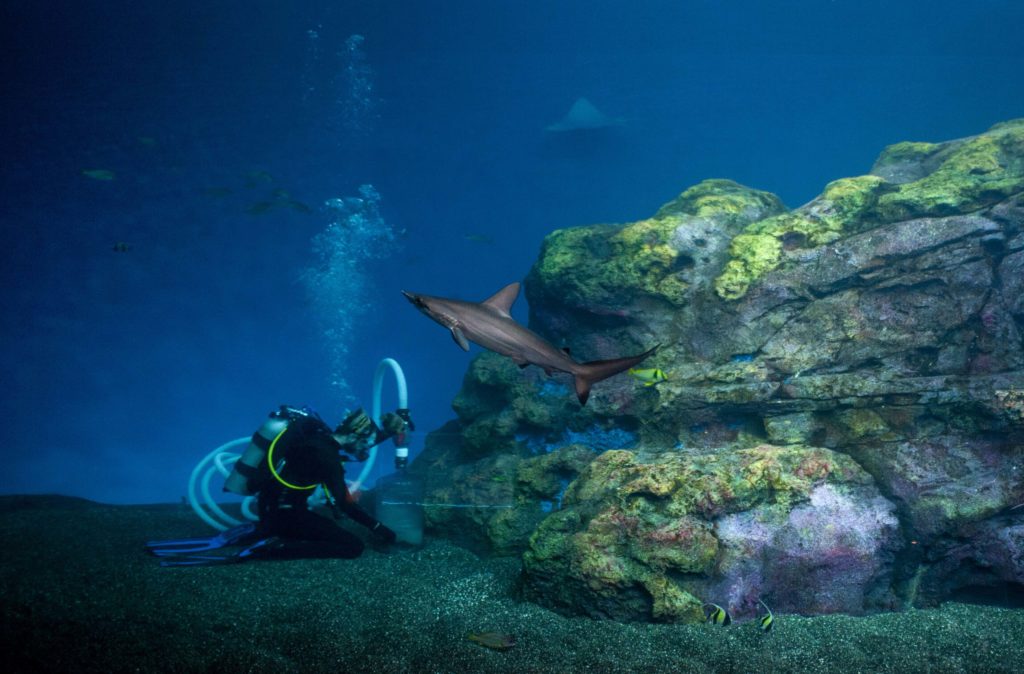In clear, blue Baja Bay, three scuba divers are drifting alongside eagle rays and brightly-colored fish. They’re moving slowly, and unlike most divers in tropical waters, they’re not gazing admiringly at the animals around them. Because these divers are aquarists at Point Defiance Zoo & Aquarium – and they’re hard at work.

“We clean, we scrub, we wipe,” explains Heidi Wilken, a dive safety officer and aquarist who’s part of the dive team that maintains both of the Zoo’s aquariums, including the new Pacific Seas Aquarium that houses Baja Bay. “I like to describe it as being an underwater custodian.”
Of course, the Zoo’s trained divers care for animals as well, both in and out of water: feeding, training and carefully studying their marine animals to make sure everyone is healthy and comfortable.
But part of Zoo work is cleaning up, and aquariums are no exception. It just looks a little more glamorous.
Vacuuming the gravel

“Wow!” calls a little boy, eyes round as saucers. Palms pressed on the curved window, he’s peering into Baja Bay where Wilken is floating along the bottom, an inch at a time, holding a giant cylinder that trails a tube out of the exhibit. Seeing him, she gives a quick wave and “ok” signal, then returns to work. Essentially, she’s vacuuming: The cylinder is a giant vacuum that sucks up gravel, pulls up the lighter food and fish waste into the tube, then releases clean gravel as Wilken lifts the cylinder.
Then she replaces it a few inches away and repeats the process – all around the floor of the 280,000-gallon habitat.
Nearby are two other divers. One is scrubbing the central sea mount clean of algae and debris; the other is wiping the huge curved acrylic window with a care usually reserved for owners of expensive vintage cars. It’s a job that takes 40 minutes to complete.
“Any little pebble or sand grain will scratch the surface,” explains Wilken, “so we are constantly wiping it clean.”
Tracking teeth

While divers work in most of the Pacific Seas Aquarium habitats, there’s one job unique to Baja Bay: picking up eagle ray teeth.
“Like other rays, eagle rays have flat plates of teeth they use to crush food, like clam shells,” says Tyler Rankin, the diver on tooth duty that day, and one of the lead aquarists for Baja Bay. “The teeth fit together in a row and are constantly moving forward and falling out as the eagle rays grow new ones.”
In fact, says Rankin, the aquarists give the rays whole clams twice a week to help them shed teeth – kind of like a dentist visit, only delicious.
And then it’s the divers’ job to float along and look for those teeth. As Rankin spots one – white, about an inch long – he tucks it carefully inside his dive glove for safekeeping. He’s also looking for teeth from the hammerhead sharks, who lose them in the same way.
“We like to track them, to monitor the animals’ overall health,” explains Rankin.

Baja takes a lot of cleaning – two or three divers working for up to an hour, three times a week, with surface support from other aquarists. Each habitat has its own challenges: some are only just big enough for a diver to turn around, others are filled with spiky sea urchins, and in the giant Pacific octopus habitat, one aquarist cleans while someone else distracts the octopus.
“It’s very different from open water diving – you have to move slowly and be incredibly careful where you put your feet and hands,” Wilken says.
But it’s a job that she loves.
“You can hear your own bubbles,” Wilken says. “Sometimes you hear the bigger fish all move at once, or sharks snapping their jaws. You can’t hear the guests watching you, but I love seeing them. And I want the exhibits to be really clean – it’s a great feeling, kind of like cleaning your house. It’s very Zen.”
WATCH FOR DIVERS: The Pacific Seas Aquarium divers are not on a regular public schedule, so come often and watch for them working!
-Rosemary Ponnekanti, PDZA